Sound
VerifiedAdded on 2023/03/31
|13
|1439
|196
AI Summary
This document discusses various aspects of sound, including construction design solutions to reduce noise, flanking sound transmission, structure-borne sound transmission, and auditorium design for live theatre. It provides explanations, diagrams, and examples to help understand these concepts. The document also includes references for further reading.
Contribute Materials
Your contribution can guide someone’s learning journey. Share your
documents today.
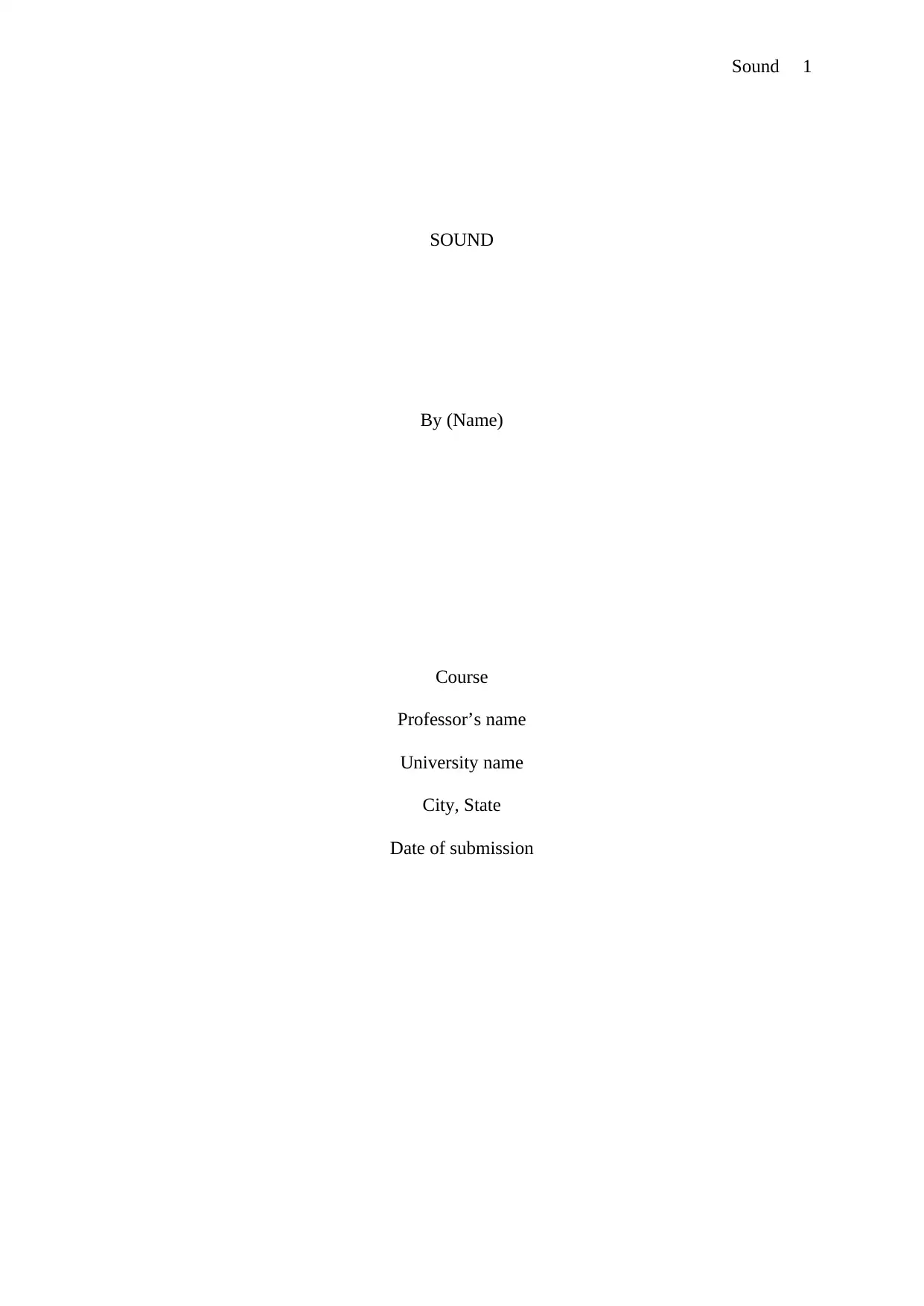
Sound 1
SOUND
By (Name)
Course
Professor’s name
University name
City, State
Date of submission
SOUND
By (Name)
Course
Professor’s name
University name
City, State
Date of submission
Secure Best Marks with AI Grader
Need help grading? Try our AI Grader for instant feedback on your assignments.
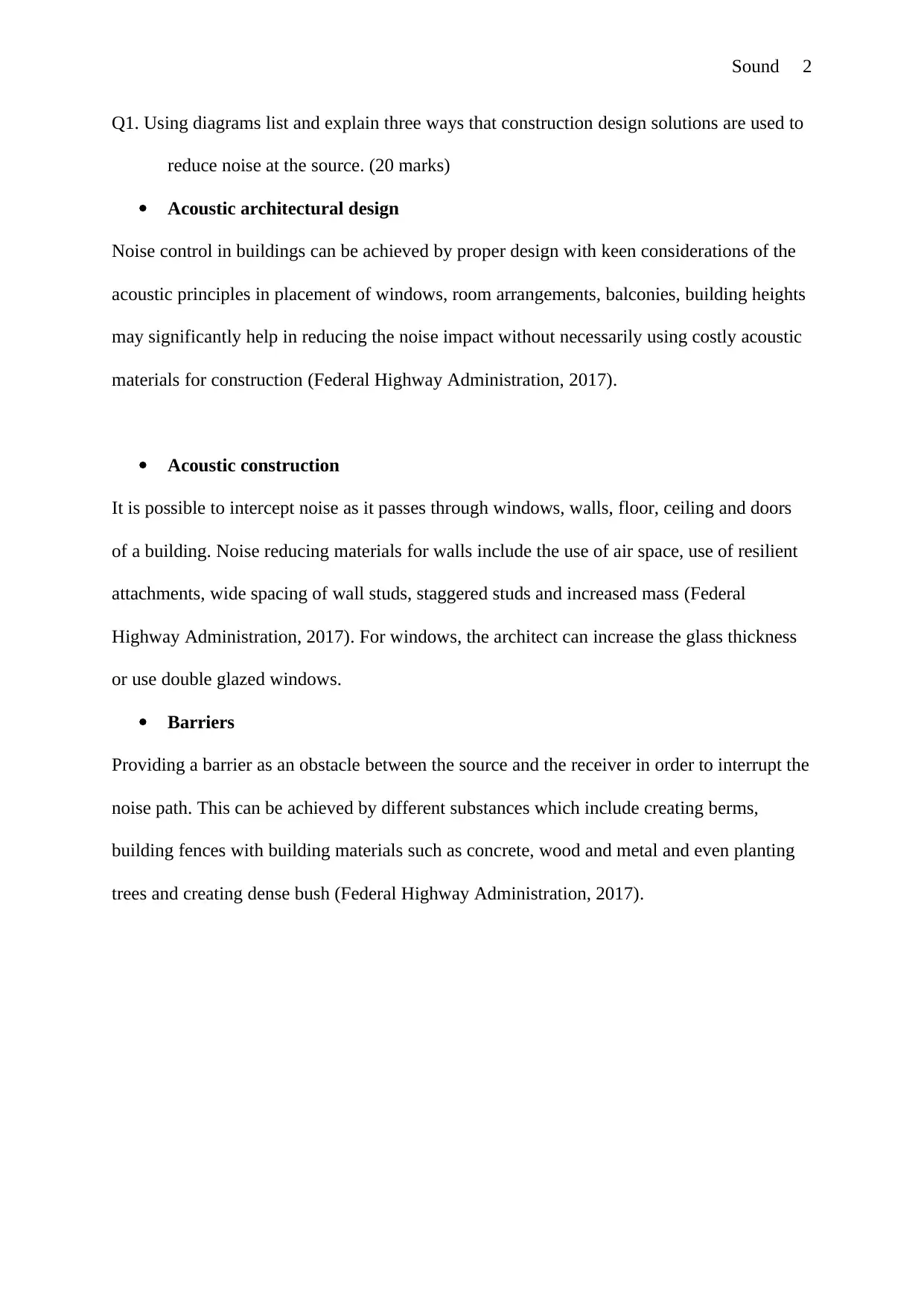
Sound 2
Q1. Using diagrams list and explain three ways that construction design solutions are used to
reduce noise at the source. (20 marks)
Acoustic architectural design
Noise control in buildings can be achieved by proper design with keen considerations of the
acoustic principles in placement of windows, room arrangements, balconies, building heights
may significantly help in reducing the noise impact without necessarily using costly acoustic
materials for construction (Federal Highway Administration, 2017).
Acoustic construction
It is possible to intercept noise as it passes through windows, walls, floor, ceiling and doors
of a building. Noise reducing materials for walls include the use of air space, use of resilient
attachments, wide spacing of wall studs, staggered studs and increased mass (Federal
Highway Administration, 2017). For windows, the architect can increase the glass thickness
or use double glazed windows.
Barriers
Providing a barrier as an obstacle between the source and the receiver in order to interrupt the
noise path. This can be achieved by different substances which include creating berms,
building fences with building materials such as concrete, wood and metal and even planting
trees and creating dense bush (Federal Highway Administration, 2017).
Q1. Using diagrams list and explain three ways that construction design solutions are used to
reduce noise at the source. (20 marks)
Acoustic architectural design
Noise control in buildings can be achieved by proper design with keen considerations of the
acoustic principles in placement of windows, room arrangements, balconies, building heights
may significantly help in reducing the noise impact without necessarily using costly acoustic
materials for construction (Federal Highway Administration, 2017).
Acoustic construction
It is possible to intercept noise as it passes through windows, walls, floor, ceiling and doors
of a building. Noise reducing materials for walls include the use of air space, use of resilient
attachments, wide spacing of wall studs, staggered studs and increased mass (Federal
Highway Administration, 2017). For windows, the architect can increase the glass thickness
or use double glazed windows.
Barriers
Providing a barrier as an obstacle between the source and the receiver in order to interrupt the
noise path. This can be achieved by different substances which include creating berms,
building fences with building materials such as concrete, wood and metal and even planting
trees and creating dense bush (Federal Highway Administration, 2017).
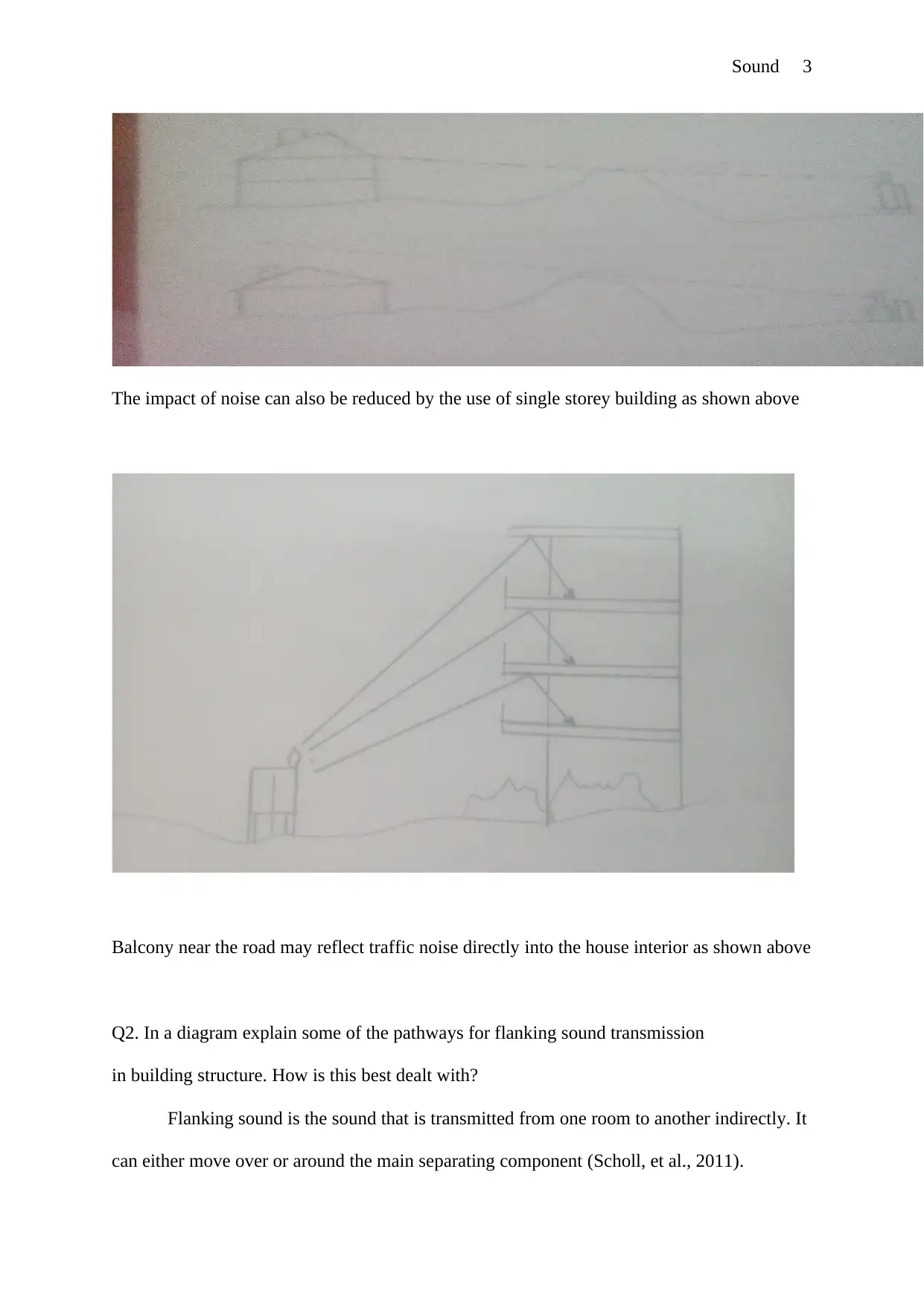
Sound 3
The impact of noise can also be reduced by the use of single storey building as shown above
Balcony near the road may reflect traffic noise directly into the house interior as shown above
Q2. In a diagram explain some of the pathways for flanking sound transmission
in building structure. How is this best dealt with?
Flanking sound is the sound that is transmitted from one room to another indirectly. It
can either move over or around the main separating component (Scholl, et al., 2011).
The impact of noise can also be reduced by the use of single storey building as shown above
Balcony near the road may reflect traffic noise directly into the house interior as shown above
Q2. In a diagram explain some of the pathways for flanking sound transmission
in building structure. How is this best dealt with?
Flanking sound is the sound that is transmitted from one room to another indirectly. It
can either move over or around the main separating component (Scholl, et al., 2011).
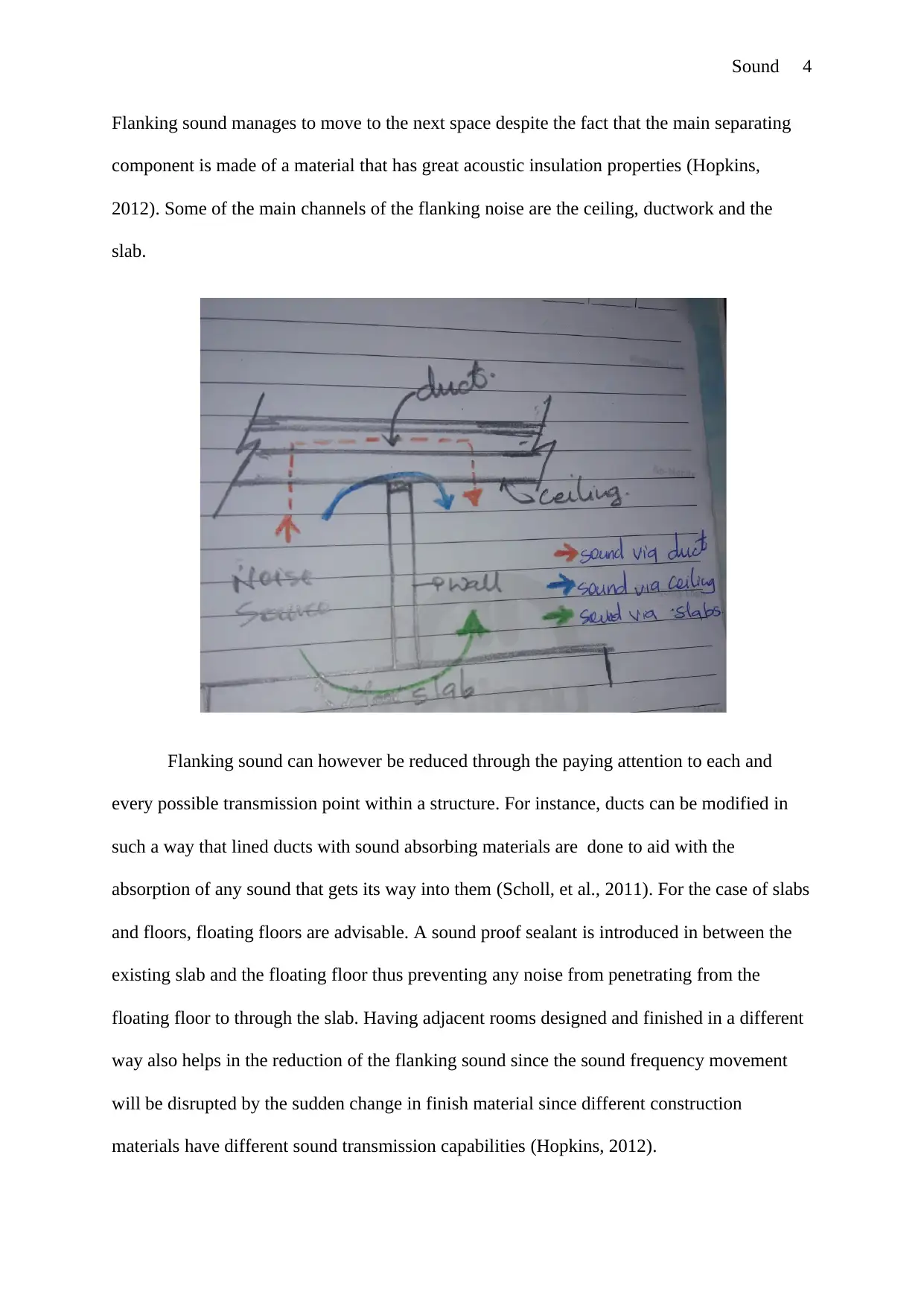
Sound 4
Flanking sound manages to move to the next space despite the fact that the main separating
component is made of a material that has great acoustic insulation properties (Hopkins,
2012). Some of the main channels of the flanking noise are the ceiling, ductwork and the
slab.
Flanking sound can however be reduced through the paying attention to each and
every possible transmission point within a structure. For instance, ducts can be modified in
such a way that lined ducts with sound absorbing materials are done to aid with the
absorption of any sound that gets its way into them (Scholl, et al., 2011). For the case of slabs
and floors, floating floors are advisable. A sound proof sealant is introduced in between the
existing slab and the floating floor thus preventing any noise from penetrating from the
floating floor to through the slab. Having adjacent rooms designed and finished in a different
way also helps in the reduction of the flanking sound since the sound frequency movement
will be disrupted by the sudden change in finish material since different construction
materials have different sound transmission capabilities (Hopkins, 2012).
Flanking sound manages to move to the next space despite the fact that the main separating
component is made of a material that has great acoustic insulation properties (Hopkins,
2012). Some of the main channels of the flanking noise are the ceiling, ductwork and the
slab.
Flanking sound can however be reduced through the paying attention to each and
every possible transmission point within a structure. For instance, ducts can be modified in
such a way that lined ducts with sound absorbing materials are done to aid with the
absorption of any sound that gets its way into them (Scholl, et al., 2011). For the case of slabs
and floors, floating floors are advisable. A sound proof sealant is introduced in between the
existing slab and the floating floor thus preventing any noise from penetrating from the
floating floor to through the slab. Having adjacent rooms designed and finished in a different
way also helps in the reduction of the flanking sound since the sound frequency movement
will be disrupted by the sudden change in finish material since different construction
materials have different sound transmission capabilities (Hopkins, 2012).
Secure Best Marks with AI Grader
Need help grading? Try our AI Grader for instant feedback on your assignments.
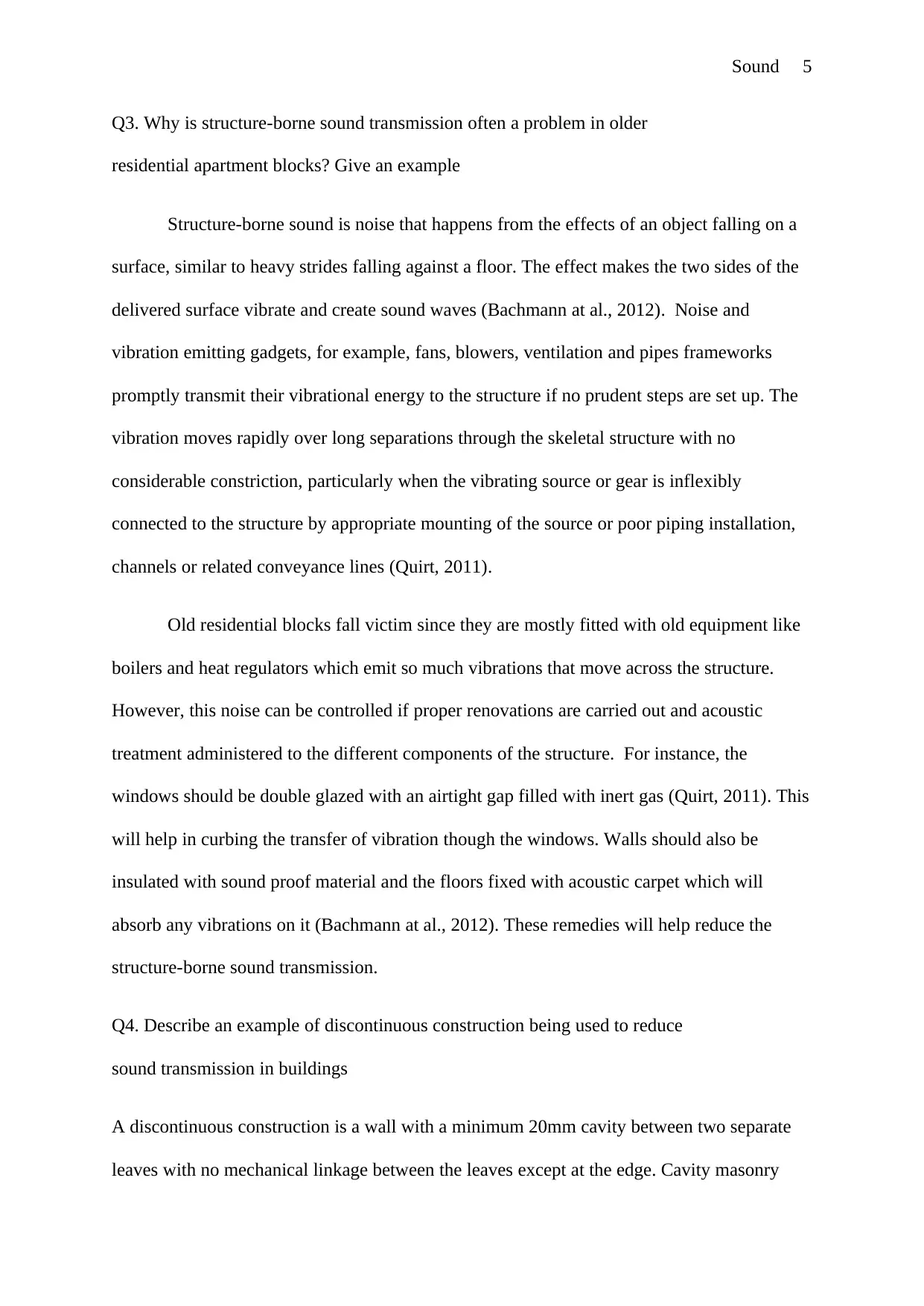
Sound 5
Q3. Why is structure-borne sound transmission often a problem in older
residential apartment blocks? Give an example
Structure-borne sound is noise that happens from the effects of an object falling on a
surface, similar to heavy strides falling against a floor. The effect makes the two sides of the
delivered surface vibrate and create sound waves (Bachmann at al., 2012). Noise and
vibration emitting gadgets, for example, fans, blowers, ventilation and pipes frameworks
promptly transmit their vibrational energy to the structure if no prudent steps are set up. The
vibration moves rapidly over long separations through the skeletal structure with no
considerable constriction, particularly when the vibrating source or gear is inflexibly
connected to the structure by appropriate mounting of the source or poor piping installation,
channels or related conveyance lines (Quirt, 2011).
Old residential blocks fall victim since they are mostly fitted with old equipment like
boilers and heat regulators which emit so much vibrations that move across the structure.
However, this noise can be controlled if proper renovations are carried out and acoustic
treatment administered to the different components of the structure. For instance, the
windows should be double glazed with an airtight gap filled with inert gas (Quirt, 2011). This
will help in curbing the transfer of vibration though the windows. Walls should also be
insulated with sound proof material and the floors fixed with acoustic carpet which will
absorb any vibrations on it (Bachmann at al., 2012). These remedies will help reduce the
structure-borne sound transmission.
Q4. Describe an example of discontinuous construction being used to reduce
sound transmission in buildings
A discontinuous construction is a wall with a minimum 20mm cavity between two separate
leaves with no mechanical linkage between the leaves except at the edge. Cavity masonry
Q3. Why is structure-borne sound transmission often a problem in older
residential apartment blocks? Give an example
Structure-borne sound is noise that happens from the effects of an object falling on a
surface, similar to heavy strides falling against a floor. The effect makes the two sides of the
delivered surface vibrate and create sound waves (Bachmann at al., 2012). Noise and
vibration emitting gadgets, for example, fans, blowers, ventilation and pipes frameworks
promptly transmit their vibrational energy to the structure if no prudent steps are set up. The
vibration moves rapidly over long separations through the skeletal structure with no
considerable constriction, particularly when the vibrating source or gear is inflexibly
connected to the structure by appropriate mounting of the source or poor piping installation,
channels or related conveyance lines (Quirt, 2011).
Old residential blocks fall victim since they are mostly fitted with old equipment like
boilers and heat regulators which emit so much vibrations that move across the structure.
However, this noise can be controlled if proper renovations are carried out and acoustic
treatment administered to the different components of the structure. For instance, the
windows should be double glazed with an airtight gap filled with inert gas (Quirt, 2011). This
will help in curbing the transfer of vibration though the windows. Walls should also be
insulated with sound proof material and the floors fixed with acoustic carpet which will
absorb any vibrations on it (Bachmann at al., 2012). These remedies will help reduce the
structure-borne sound transmission.
Q4. Describe an example of discontinuous construction being used to reduce
sound transmission in buildings
A discontinuous construction is a wall with a minimum 20mm cavity between two separate
leaves with no mechanical linkage between the leaves except at the edge. Cavity masonry
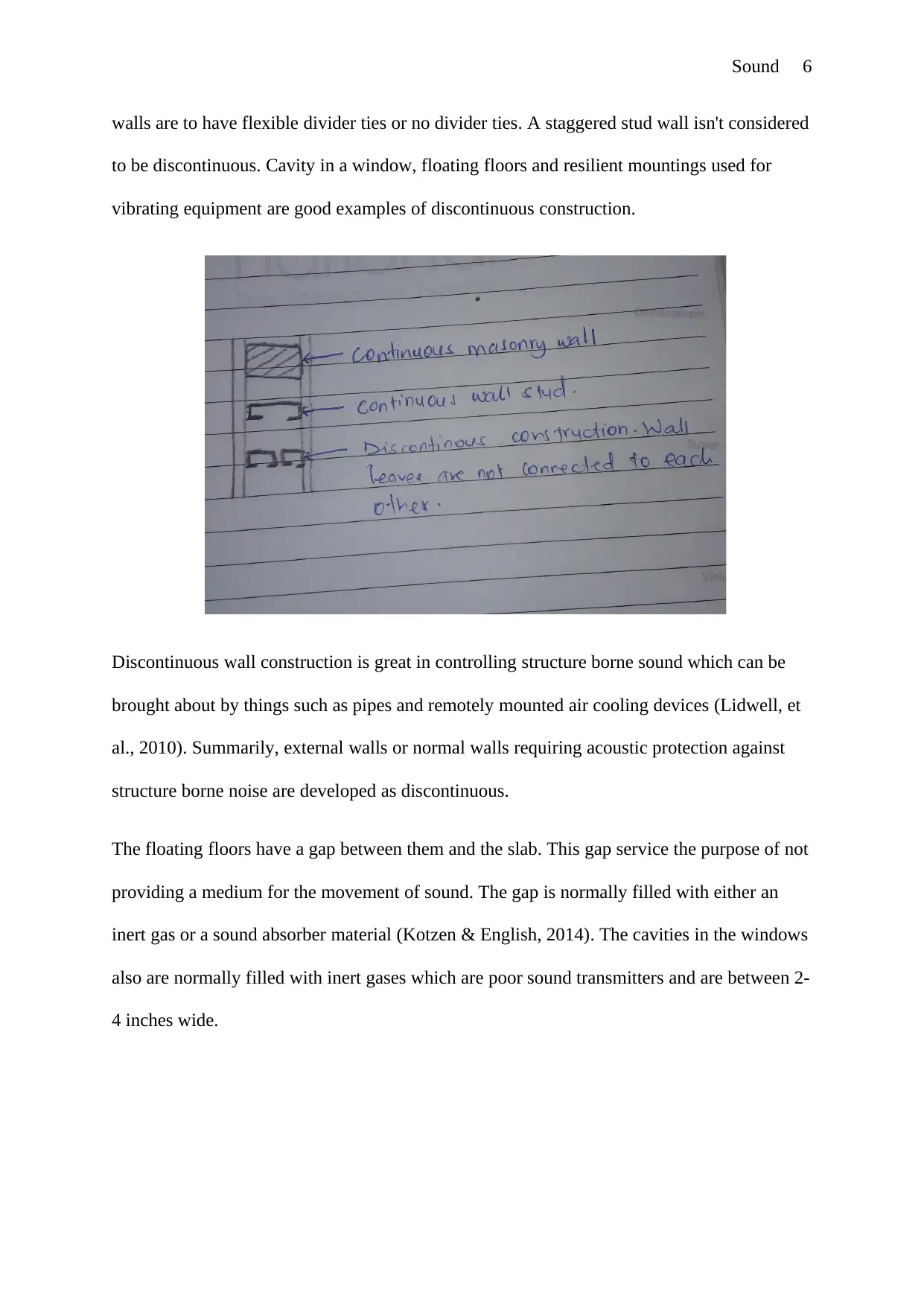
Sound 6
walls are to have flexible divider ties or no divider ties. A staggered stud wall isn't considered
to be discontinuous. Cavity in a window, floating floors and resilient mountings used for
vibrating equipment are good examples of discontinuous construction.
Discontinuous wall construction is great in controlling structure borne sound which can be
brought about by things such as pipes and remotely mounted air cooling devices (Lidwell, et
al., 2010). Summarily, external walls or normal walls requiring acoustic protection against
structure borne noise are developed as discontinuous.
The floating floors have a gap between them and the slab. This gap service the purpose of not
providing a medium for the movement of sound. The gap is normally filled with either an
inert gas or a sound absorber material (Kotzen & English, 2014). The cavities in the windows
also are normally filled with inert gases which are poor sound transmitters and are between 2-
4 inches wide.
walls are to have flexible divider ties or no divider ties. A staggered stud wall isn't considered
to be discontinuous. Cavity in a window, floating floors and resilient mountings used for
vibrating equipment are good examples of discontinuous construction.
Discontinuous wall construction is great in controlling structure borne sound which can be
brought about by things such as pipes and remotely mounted air cooling devices (Lidwell, et
al., 2010). Summarily, external walls or normal walls requiring acoustic protection against
structure borne noise are developed as discontinuous.
The floating floors have a gap between them and the slab. This gap service the purpose of not
providing a medium for the movement of sound. The gap is normally filled with either an
inert gas or a sound absorber material (Kotzen & English, 2014). The cavities in the windows
also are normally filled with inert gases which are poor sound transmitters and are between 2-
4 inches wide.
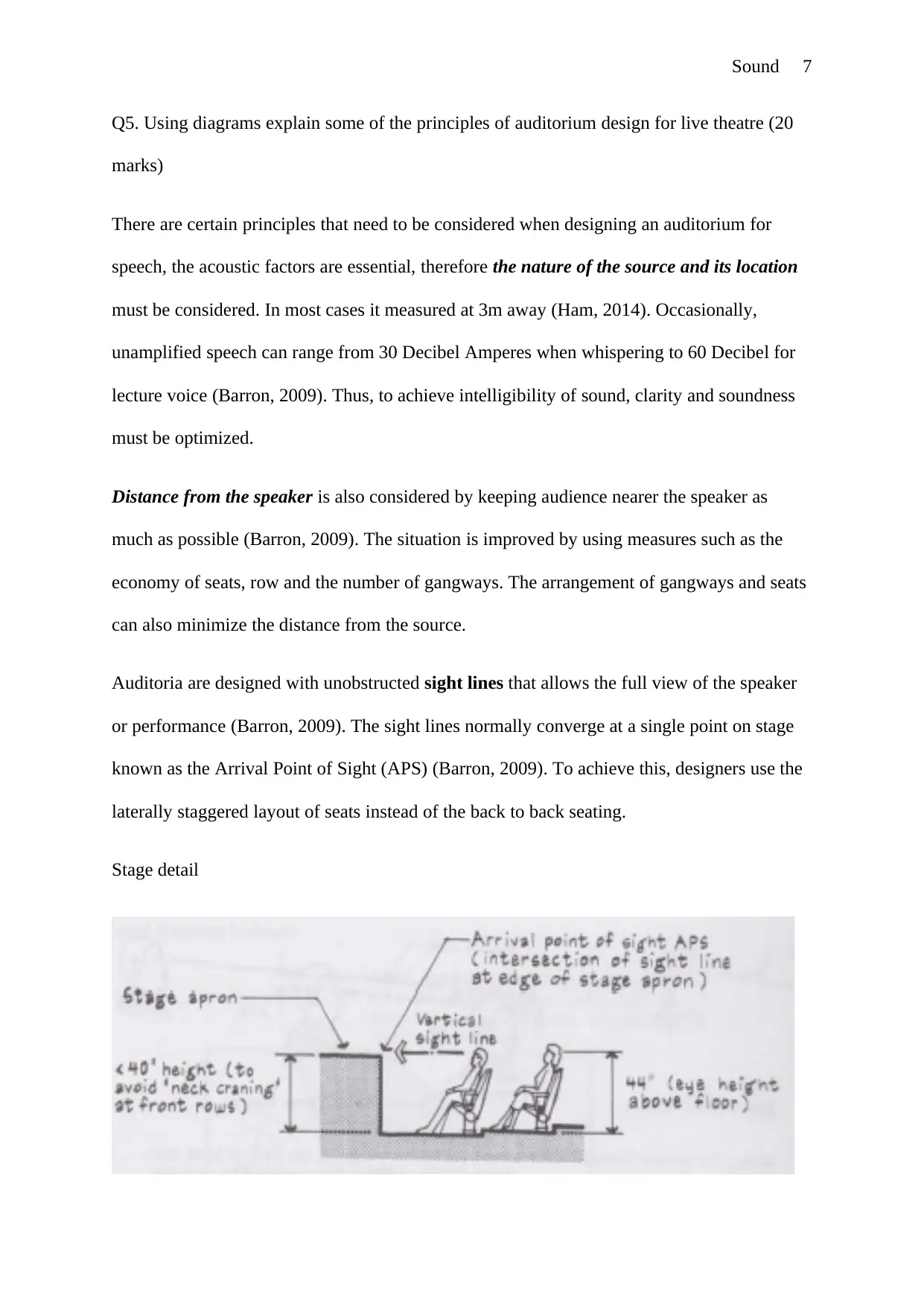
Sound 7
Q5. Using diagrams explain some of the principles of auditorium design for live theatre (20
marks)
There are certain principles that need to be considered when designing an auditorium for
speech, the acoustic factors are essential, therefore the nature of the source and its location
must be considered. In most cases it measured at 3m away (Ham, 2014). Occasionally,
unamplified speech can range from 30 Decibel Amperes when whispering to 60 Decibel for
lecture voice (Barron, 2009). Thus, to achieve intelligibility of sound, clarity and soundness
must be optimized.
Distance from the speaker is also considered by keeping audience nearer the speaker as
much as possible (Barron, 2009). The situation is improved by using measures such as the
economy of seats, row and the number of gangways. The arrangement of gangways and seats
can also minimize the distance from the source.
Auditoria are designed with unobstructed sight lines that allows the full view of the speaker
or performance (Barron, 2009). The sight lines normally converge at a single point on stage
known as the Arrival Point of Sight (APS) (Barron, 2009). To achieve this, designers use the
laterally staggered layout of seats instead of the back to back seating.
Stage detail
Q5. Using diagrams explain some of the principles of auditorium design for live theatre (20
marks)
There are certain principles that need to be considered when designing an auditorium for
speech, the acoustic factors are essential, therefore the nature of the source and its location
must be considered. In most cases it measured at 3m away (Ham, 2014). Occasionally,
unamplified speech can range from 30 Decibel Amperes when whispering to 60 Decibel for
lecture voice (Barron, 2009). Thus, to achieve intelligibility of sound, clarity and soundness
must be optimized.
Distance from the speaker is also considered by keeping audience nearer the speaker as
much as possible (Barron, 2009). The situation is improved by using measures such as the
economy of seats, row and the number of gangways. The arrangement of gangways and seats
can also minimize the distance from the source.
Auditoria are designed with unobstructed sight lines that allows the full view of the speaker
or performance (Barron, 2009). The sight lines normally converge at a single point on stage
known as the Arrival Point of Sight (APS) (Barron, 2009). To achieve this, designers use the
laterally staggered layout of seats instead of the back to back seating.
Stage detail
Paraphrase This Document
Need a fresh take? Get an instant paraphrase of this document with our AI Paraphraser
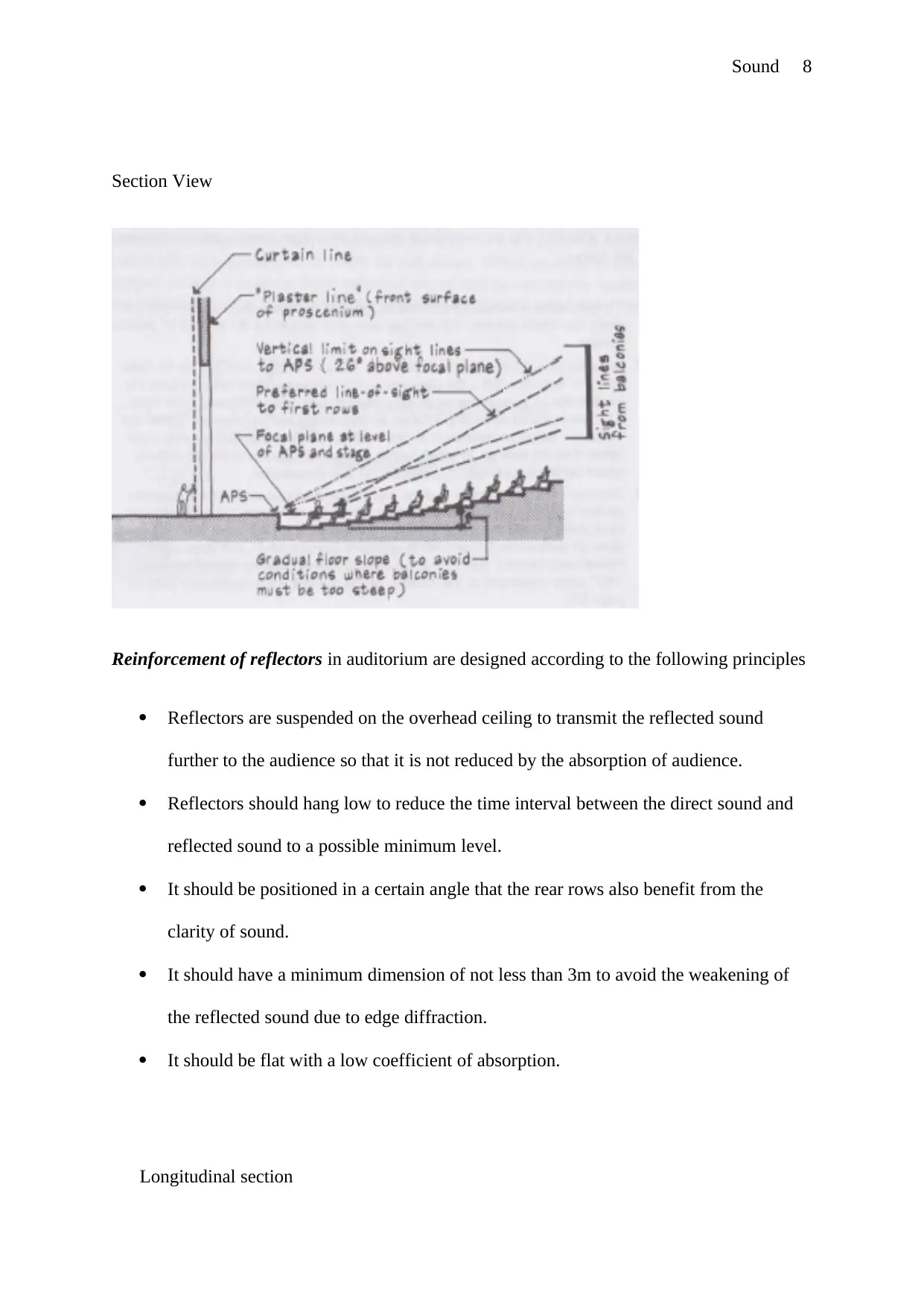
Sound 8
Section View
Reinforcement of reflectors in auditorium are designed according to the following principles
Reflectors are suspended on the overhead ceiling to transmit the reflected sound
further to the audience so that it is not reduced by the absorption of audience.
Reflectors should hang low to reduce the time interval between the direct sound and
reflected sound to a possible minimum level.
It should be positioned in a certain angle that the rear rows also benefit from the
clarity of sound.
It should have a minimum dimension of not less than 3m to avoid the weakening of
the reflected sound due to edge diffraction.
It should be flat with a low coefficient of absorption.
Longitudinal section
Section View
Reinforcement of reflectors in auditorium are designed according to the following principles
Reflectors are suspended on the overhead ceiling to transmit the reflected sound
further to the audience so that it is not reduced by the absorption of audience.
Reflectors should hang low to reduce the time interval between the direct sound and
reflected sound to a possible minimum level.
It should be positioned in a certain angle that the rear rows also benefit from the
clarity of sound.
It should have a minimum dimension of not less than 3m to avoid the weakening of
the reflected sound due to edge diffraction.
It should be flat with a low coefficient of absorption.
Longitudinal section
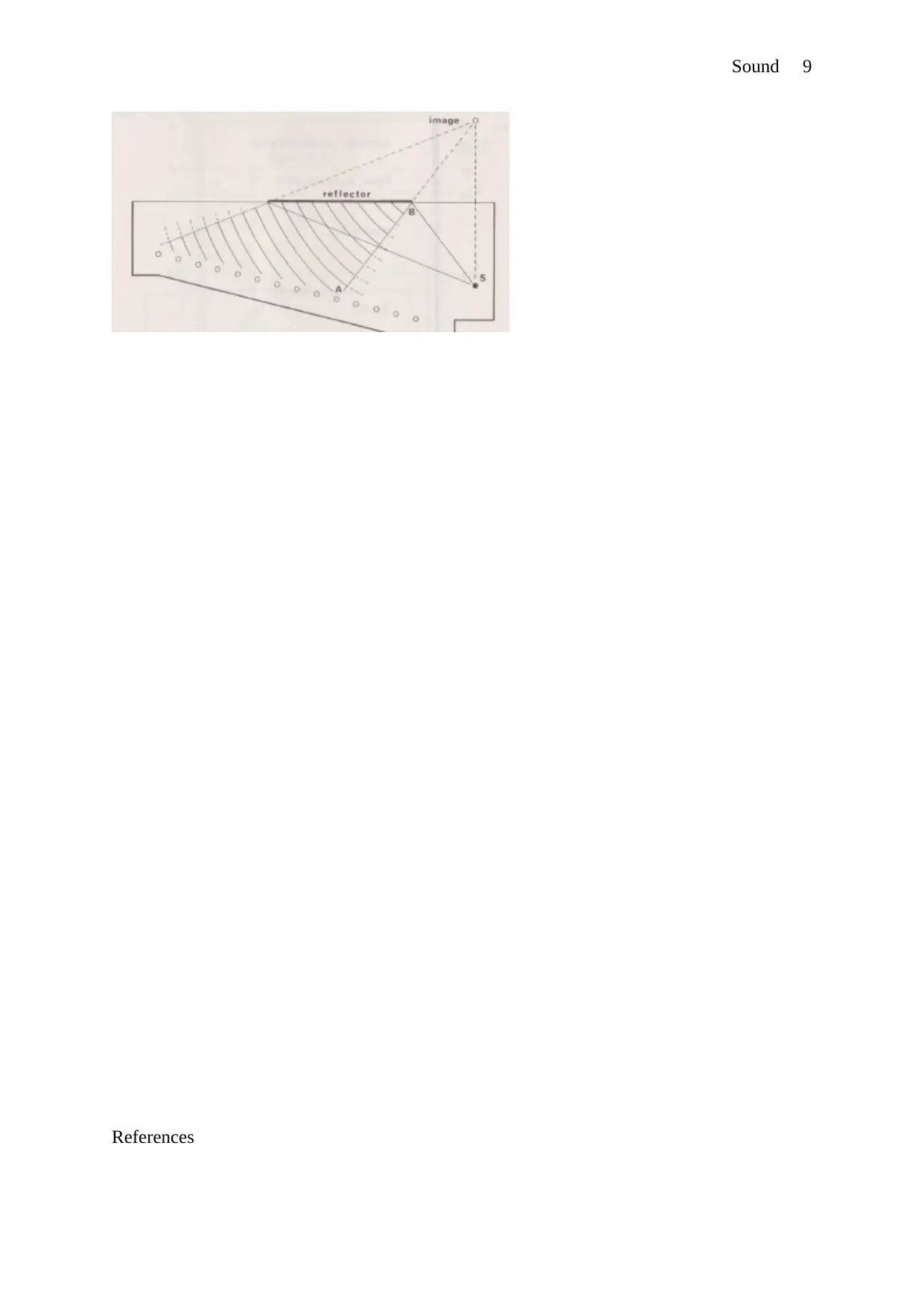
Sound 9
References
References
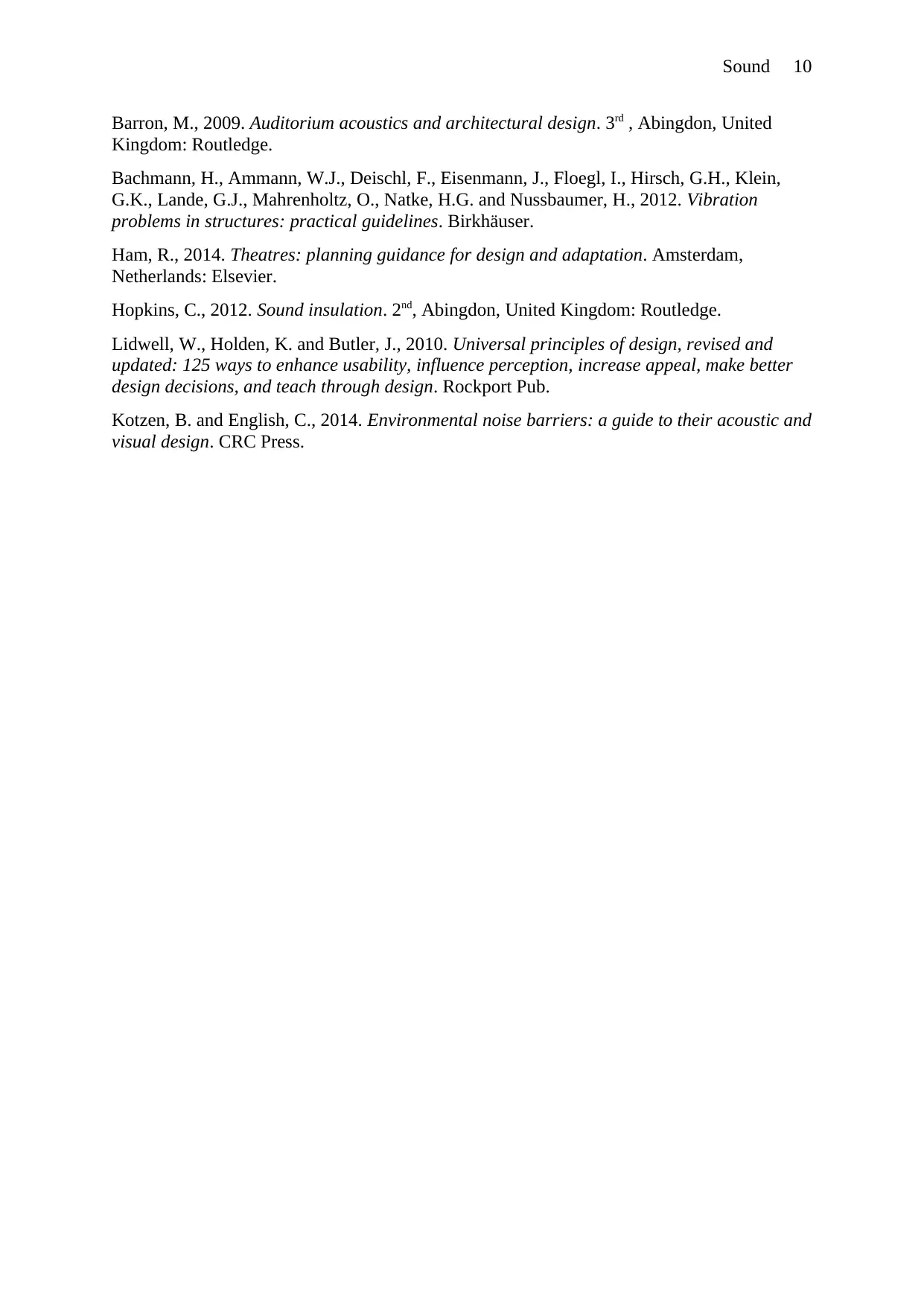
Sound 10
Barron, M., 2009. Auditorium acoustics and architectural design. 3rd , Abingdon, United
Kingdom: Routledge.
Bachmann, H., Ammann, W.J., Deischl, F., Eisenmann, J., Floegl, I., Hirsch, G.H., Klein,
G.K., Lande, G.J., Mahrenholtz, O., Natke, H.G. and Nussbaumer, H., 2012. Vibration
problems in structures: practical guidelines. Birkhäuser.
Ham, R., 2014. Theatres: planning guidance for design and adaptation. Amsterdam,
Netherlands: Elsevier.
Hopkins, C., 2012. Sound insulation. 2nd, Abingdon, United Kingdom: Routledge.
Lidwell, W., Holden, K. and Butler, J., 2010. Universal principles of design, revised and
updated: 125 ways to enhance usability, influence perception, increase appeal, make better
design decisions, and teach through design. Rockport Pub.
Kotzen, B. and English, C., 2014. Environmental noise barriers: a guide to their acoustic and
visual design. CRC Press.
Barron, M., 2009. Auditorium acoustics and architectural design. 3rd , Abingdon, United
Kingdom: Routledge.
Bachmann, H., Ammann, W.J., Deischl, F., Eisenmann, J., Floegl, I., Hirsch, G.H., Klein,
G.K., Lande, G.J., Mahrenholtz, O., Natke, H.G. and Nussbaumer, H., 2012. Vibration
problems in structures: practical guidelines. Birkhäuser.
Ham, R., 2014. Theatres: planning guidance for design and adaptation. Amsterdam,
Netherlands: Elsevier.
Hopkins, C., 2012. Sound insulation. 2nd, Abingdon, United Kingdom: Routledge.
Lidwell, W., Holden, K. and Butler, J., 2010. Universal principles of design, revised and
updated: 125 ways to enhance usability, influence perception, increase appeal, make better
design decisions, and teach through design. Rockport Pub.
Kotzen, B. and English, C., 2014. Environmental noise barriers: a guide to their acoustic and
visual design. CRC Press.
Secure Best Marks with AI Grader
Need help grading? Try our AI Grader for instant feedback on your assignments.

Sound 11
Quirt, J.D., 2011. Controlling air-borne and structure-borne sound in buildings. Noise News
International, 19(2), pp.37-47.
Quirt, J.D., 2011. Controlling air-borne and structure-borne sound in buildings. Noise News
International, 19(2), pp.37-47.

Sound 12

Sound 13
Scholl, W., Lang, J. and Wittstockh, V., 2011. Rating of sound insulation at present and in
future. The revision of ISO 717. Acta acustica united with acustica, 97(4), pp.686-698.
Scholl, W., Lang, J. and Wittstockh, V., 2011. Rating of sound insulation at present and in
future. The revision of ISO 717. Acta acustica united with acustica, 97(4), pp.686-698.
1 out of 13
![[object Object]](/_next/static/media/star-bottom.7253800d.svg)



